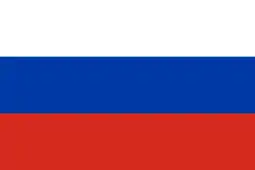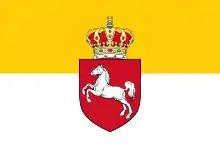Duke William of Mecklenburg-Schwerin
Duke Wilhelm of Mecklenburg-Schwerin (German: Friedrich Wilhelm Nicolas; Ludwigsburg, 5 March 1827, Ludwigslust – 28 July 1879, Heidelberg), was the second son of Hereditary Grand Duke Paul Friedrich of Mecklenburg and his wife Princess Alexandrine of Prussia, daughter of Frederick William III.
| Wilhelm of Mecklenburg-Schwerin | |||||
|---|---|---|---|---|---|
 | |||||
| Predecessor | Paul Frederick | ||||
| Successor | Frederick Francis III | ||||
| Born | 5 March 1827 Ludwigslust | ||||
| Died | 28 July 1879 (aged 52) Heidelberg | ||||
| Spouse | Alexandrine of Prussia | ||||
| Issue | Duchess Charlotte | ||||
| |||||
| House | House of Mecklenburg-Schwerin | ||||
| Father | Paul Frederick, Grand Duke of Mecklenburg-Schwerin | ||||
| Mother | Alexandrine of Prussia | ||||
Life
He enlisted in the Prussian Army and became commander of the 6th (Brandenburg) Cuirassiers "Emperor Nicholas I of Russia". William had a reputation for drunkenness and a dissolute character. On two occasions he was deprived of his command in the Prussian army and he proposed marriage to the celebrated ballerina Marie Taglioni; consequently he was generally considered to be the "black sheep" of the family.[1] Under family pressure, on 9 December 1865, he married Alexandrine of Prussia, daughter of Albert of Prussia and Marianne of Orange-Nassau. William settled with his wife at Bellevue Palace in Berlin. The marriage was unhappy and the couple had an only child: Charlotte (1868-1944) who married Prince Heinrich XVIII Reuss of Köstritz.
William took part in the Austro-Prussian War of 1866 as a major general in command of a cavalry brigade in the First Army. He managed, with difficulty, to secure a command in the Prussian Army during the Franco-Prussian War, leading the 6th Cavalry Division, but he was wounded on 9 September 1870 in Laon. As a result, he was long absent from the front and he showed a great lack of energy at the Battle of Le Mans. In 1873 he became commander of the 22nd Division in Kassel, completed in 1874 but it was only an honorary position. He died on 28 July 1879.[1]
Honours
He received the following orders and decorations:[2]
 Mecklenburg:
Mecklenburg:
- Grand Cross of the Wendish Crown, with Crown in Ore and Collar
- Military Merit Cross, 2nd and 1st Classes (Schwerin)
 Russian Empire:
Russian Empire:
- Knight of St. Andrew
- Knight of St. Alexander Nevsky
- Knight of the White Eagle
- Knight of St. Anna, 1st Class
 Austrian Empire: Grand Cross of the Imperial Order of Leopold, 1852[3]
Austrian Empire: Grand Cross of the Imperial Order of Leopold, 1852[3].svg.png.webp) Baden:[4]
Baden:[4]
- Knight of the House Order of Fidelity, 1849
- Grand Cross of the Zähringer Lion, 1849
 Brunswick: Grand Cross of Henry the Lion
Brunswick: Grand Cross of Henry the Lion.svg.png.webp)
.svg.png.webp)
.svg.png.webp) Ernestine duchies: Grand Cross of the Saxe-Ernestine House Order, October 1862[5]
Ernestine duchies: Grand Cross of the Saxe-Ernestine House Order, October 1862[5].svg.png.webp) Kingdom of Prussia:
Kingdom of Prussia:
- Knight of the Black Eagle
- Grand Cross of the Red Eagle, in Saltire and with Swords
- Pour le Mérite (military), 17 September 1866[6]
- Iron Cross, 1st and 2nd Classes
 Kingdom of Hanover: Grand Cross of the Royal Guelphic Order, 1847[7]
Kingdom of Hanover: Grand Cross of the Royal Guelphic Order, 1847[7] Oldenburg: Grand Cross of the Order of Duke Peter Friedrich Ludwig, with Golden Crown, 5 December 1865[8]
Oldenburg: Grand Cross of the Order of Duke Peter Friedrich Ludwig, with Golden Crown, 5 December 1865[8]
Ancestors
Notes
- "Romances of a Royal House", The Washington Post, 20 April 1906
- Mecklenburg-Schwerin (Germany) Statistisches Landesamt (1878). "Grossherzogliches Haus". Mecklenburg-Schwerinsches Staatshandbuch. p. 4.
- "Ritter-Orden", Hof- und Staatshandbuch der Österreichisch-Ungarischen Monarchie, 1878, pp. 73, retrieved 23 July 2020
- Hof- und Staats-Handbuch des Großherzogtum Baden (1868), "Großherzogliche Orden" pp. 50, 60
- Staatshandbücher für das Herzogtums Sachsen-Altenburg (1869), "Herzogliche Sachsen-Ernestinischer Hausorden" p. 21
- Lehmann, Gustaf (1913). Die Ritter des Ordens pour le mérite 1812–1913 [The Knights of the Order of the Pour le Mérite] (in German). 2. Berlin: Ernst Siegfried Mittler & Sohn. p. 472.
- Staat Hannover (1865). Hof- und Staatshandbuch für das Königreich Hannover: 1865. Berenberg. p. 76.
- Hof- und Staatshandbuch des Großherzogtums Oldenburg0: 1879. Schulze. 1879. p. 33.
